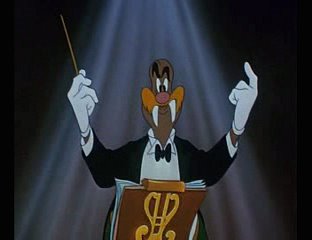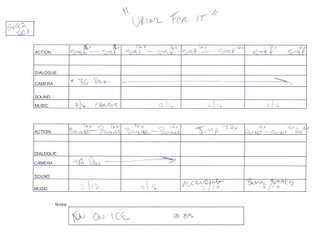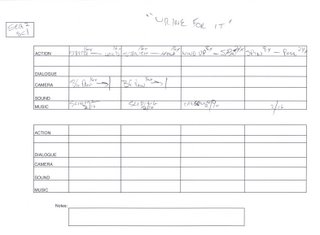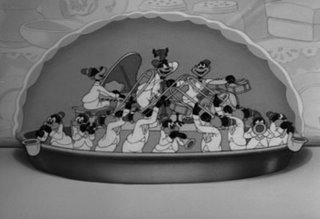 One of my favorite directors, Dick Lundy timing a cartoon.
One of my favorite directors, Dick Lundy timing a cartoon.Here's a topic that I am so glad popped up on the
Animation Archive blog, musical timing. One of the reasons I haven't moved forward with my own short that I've been working on is that I've been trying to learn how to time the animation to music, along with just learning how to draw better. Unfortunately, I haven't come across to much information on the subject other than two short chapters from Shamus Culhane's book "Animation From Scipt to Screen", so the post on the Archive along with the comments are already helping me to clear up some things. I've played bass/upright bass from years and even took lessons from a one time Atlantic records session player, Jerry Jemmott who played with Aretha Franklin, King Curtis and B.B. King and his whole "thing" was about the groove. Which was great because I love funk. Needless to say though I never learned to read music as he felt it wasn't as important but I do have a good sense of rhythm, I'm hoping that will serve me well learning to time to music. I've scanned a couple of bar sheets from Hanna Barbera'a MGM cartoons Officer Pooch and Tee for Two. There just a handful of bars but there's a wealth of information in them. Sorry they're not the best quality the originals I scanned were quite small. Plus some bar sheets from a scene in my own cartoon that I've been trying to time properly. If you're knowlegeable on the subject please feel free to leave some comments/tips, they'd be much appreciated.
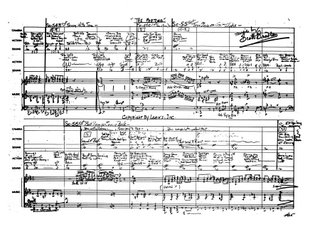
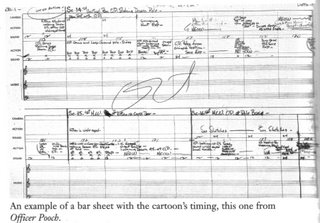
Here's the scenes from Officer Pooch that correspond to the bar sheets.
The scene I have been timing starts with a short walk/goofy jig set to a Jack Shaindlin tune "Fun On Ice", Hanna Barbera fans will no doubt recognize it. The whole walk/dance is 15 seconds. I started by listening the track and catching the beat and trying to get the beats per measure. I timed it as a march with the beat being 1-2, 1-2, etc. for each measure. I had two beats per measure. I don't know if this is musically correct but I've kind of internalized the timing where it's made sense to me. I then imported the track into Flipbook. I noticed the down beat was every 8 frames which would coincide with each step. Starting at frame 12 then 20, 28 and so on. Being able to see the music and the frames has been helpful.
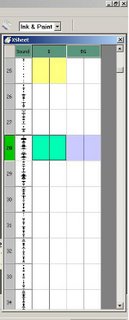
This worked out great for the walk since each step is on the down beat. Each meaure was two beats with 16 frames to each measure. My problems arose when the character jumps, this to the action that will follow will take 24 frames to complete. But in the next measure it's right back to 16 frames for each foot landing and then a pose each timed to some rhythmic brass stabs.
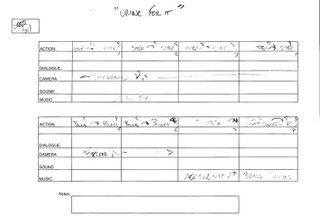
The problem grew worse when the action that followed did not stick to the beat like a walk would. The beats per measure work when just listening to the music but it seems my timing fell apart when trying to put it to animation. I'm guessing it would be simpler to time it as 24 frames or a second per measure.
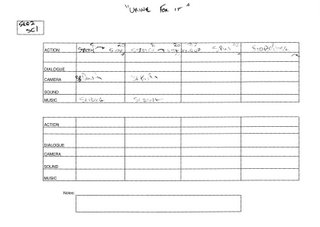
I think that the way classic cartoons were timed to music is one of the biggest differences between cartoons then and today. Watch a sneak or tip-toe walk in an old Warner's or MGM cartoon and it's perfectly in sync with the music. It brings them to life, sets a tempo, and builds tensionas not to bore the viewer. I don't think every second of a cartoon needs to be set to music or even have music, even songs have rests but meshing the cartoon with the soundtrack certainly makes timing and planning a cartoon easier. I'm hoping to someday be able to take a storyboard of mine and sit down with it and a metronome and just time it out and hopefully these posts on different blogs will help those of us who are interested to learn more about it. Many thanks to Stephen Worth for even posting on the subject.



